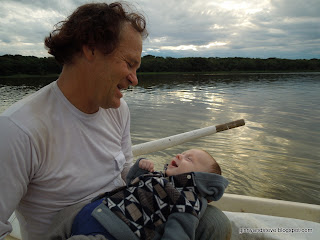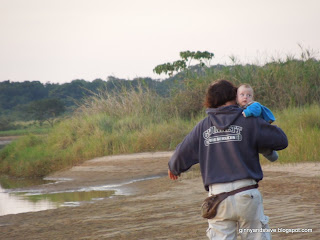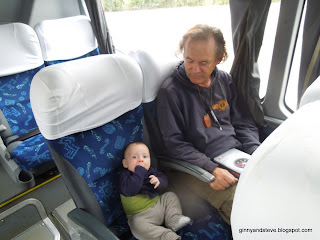Dear friends and family,
We last emailed you on May 10 from
Foz do Iguaçu, where George was born. After the month in the apartment
we moved to the Lake Itaipu Yacht Club and worked on Thurston, sleeping in a bunkhouse behind the restaurant when the
boat work was too disruptive to live aboard. George created a steady stream of
dirty clothes and diapers. Ginny washed them in a sink with a built-in
scrub-board in the camping area. The wi-fi reception was good there, so she
often Skyped with her mother and grandmother, who were eager to see George. We
dried the clothes on lines by the bunkhouse, taking them down during the cold
rains, and at night when the dew was heavy.
On May 30 we started up Lake
Itaipu, a reservoir on the Paraná River. Paraguay was still on the left (west)
bank but now we had Brazil to our right. The reservoir was an inland sea with
wooded shores. As in our two previous reservoir experiences they hadn’t removed
the trees before filling the reservoir, so snags protruded wherever the lake
was shallow. Sport fishermen fly-fished from aluminum skiffs, and commercial
fishermen in planked boats tended nets. The Honda 2-horse outboard conked out,
but we tracked the cause to the ignition cable, for which we had a spare. Ginny
rowed for the first time since she was five months pregnant. The wind was
rarely good for sailing.
George was fine with living aboard.
As necessary we applied his life jacket, ear-protectors, sunglasses, and
sunscreen. Ginny created a wrap for him whereby George is carried snugly on her
chest leaving her hands free. We shared colds, always harder on George than on
Steve or Ginny. During meals Steve read Brazilian history books, looking up the
words he didn’t know in a Portuguese-English dictionary. We dried diapers on a
line stretched between the masts.
On June 2 we reached Guaira, a
small city where there used to be falls similar to Iguaçu, but the dam has
drowned them. Somebody invited us into a creek, so we paddled in until we came
to a long, ramshackle boatshed with fifteen or so long, slender, wooden fishing
dories. We squeezed in among them. We stepped onto a low, grassy bank, crossed
a street, and found ourselves in a neighborhood of new and in-process small homes
inhabited by fishermen and their families. They were excited to meet us. They had
us over for meals and took us on errands in their rattly cars. The local press
interviewed us. Little girls brought ramen noodles, bottled water, candies. We were
told, for the umpteenth time, of someone who some years before had kayaked the
same stretch of river.
Leaving Guaira we were in current
again. We weren’t in a hurry so we ran the long-tail motor slow. averaging
seven kilometers per hour. Now both banks were Brazil, so the naval patrols
dropped off. It took two and a half days to get past Ilha Grande, our longest
riverine island to date at 130 kilometers. With the river undivided again it was
three kilometers wide: big considering how far upstream we were.
Rather than take one long break at
mid-day we tried stopping every couple hours for a quick stroll on a sand bank,
a forest trail, or in a town. On June 9 we reached the mouth of the
Paranapanema River. Thereafter São Paulo State lay on the east bank. The water
became wonderfully clear as we approached the next dam, because it had settled
out the sediment.
The Sergio Matto dam has a lock,
but could we use it? The fishermen said it’s only for big boats. We put up our
masts to look more like a sailboat, therefore deserving. We entered a canal
chiseled down through bedrock and stopped within sight of the lock. We called
for assistance on VHF Channel 16, afraid we wouldn’t understand the operator’s
Portuguese, but we managed all right. Someone took our data, consulted their
superior, and said to approach the lock. The operator was a tiny figure in a
glass structure high over the downstream gate, which he now lifted. We paddled
into the chamber, which was big enough for a hundred Thurstons, and tied to a floating bollard that slides vertically on
a track. Creaks and groans echoed through the chamber, flowed by a gentle
swirling as we rose about twenty feet. Then the upstream gate opened, this time
vertically downwards. It was dark when we emerged into this new reservoir, but
we soon found a cove to anchor in.
The next day was Steve’s 60th
birthday. The sun shone brightly, the water was clear and cool. The sandy bottom
lent itself to wading. In the following nights we camped in equally lovely coves.
They were generally creek mouths, marshy at their heads, with forested banks
and rising farmland beyond. We saw capybaras, otters, parrots, macaws, and
tapir tracks five inches across, but so far no tapirs.
On June 14 we reached Presidente
Epitacio, a small city on the east bank. We pulled into a lily-lined inlet and
nosed up to a grassy bank among some other recreational boats. The land was park-like,
gently rising. To our left a couple of steel boats were getting welded up. To
our right was a restaurant with open-air seating. As in Guaira, people took an
interest in us. Reporters arrived. The marina manager invited us to stay in a
guest house. Downtown was a ten-minute walk away.
We needed to go to the U.S.
consulate in São Paulo city to get George an American passport. Pleased with
what we had seen of Presidente Epitacio we decided to leave Thurston here and catch a bus. We had
heard of something called Couch Surfing, where people register themselves on a
web site as being willing to put up travelers. We checked. It’s popular in
Brazil and we soon got an invitation from a guy in São Paulo!
We packed light, using just our
day packs. A fellow boat owner helped us secure Thurston and took us to the bus station. At 8 PM we caught a modern
bus with reclinable seats and rolled off into the night.
Dawn found us in a huge São Paulo
transit terminal. We took a subway to Praça da Sé (Plaza of the Old Cathedral),
at the city’s core. The crowds included gold-buyers with special vests,
policemen of varying uniforms, and homeless people snoozing under brown
blankets. Nearby stood the former Jesuit school where the first mass was held
in 1554, inaugurating Brazil’s first inland settlement, seventy kilometers from
the coast and a cool 2,600 feet above sea level.
São Paulo grew as the jumping-off
point for the bandeirante
explorations, wherein hardy Portuguese canoed the rivers for years on end in
search of gold and Indian slaves. Another new type of man, the gaúcho, ranged southward, adapting the
plains to cattle herding. Here and in Paraguay everyone spoke a lingua franca
based on Tupi-Guarani. In Paraguay Guarani remained the language of the people
while in Brazil further European influxes caused Portuguese to prevail. The bandeirantes discovered gold in Ouro
Preto (Black Gold). Coffee was introduced. Millions emigrated from Italy,
Germany, Japan, and Eastern Europe. Now São Paulo, population twenty million,
is the biggest city in South America, and in the Southern Hemisphere.
We obtained an atlas that broke
the city up into 445 pages worth of maps, the minimum number capable of
depicting all its 131,249 streets. São Paulo is actually a city of many
centers, each a cluster of skyscrapers, the whole spreading over an area forty
by sixty kilometers.
We found our amiable host, Vinicius,
in a sub-city called Butantá, west of the Pinheiros River. He, his wife
Fernanda and a couple friends, all recent graduates of the U. of São Paulo
engineering school, inhabited a common-wall house in a hilly district. They gave
us the bedroom of a roommate temporarily out of town, keys, and bicycles. Our
hosts were leftists, active in the anti-corruption demonstrations then shaking
the country. They spoke English, which facilitated communication. We soon
developed close friendships with Vinicius and several others.
Next we found the U.S. Consulate,
a bus ride and train ride away. A State Department official originally from
Seattle interviewed us and approved
George’s citizenship. On the public conveyances George inevitably made new
friends, men and women of all ages who cooed at him phrases like, “Ay, que pequeninho tao bonitinho e
branquinho.” (“My what a lovely little boy, so cute and white-skinned.”)
George now smiles ecstatically in response to such entreaties. The other day we
caught him befriending a cardboard cut out of a man in the grocery store!
In the following days we toured
the Museum of the Portuguese Language, the Museum of Contemporary Art, and the
Paulista Museum (a native of São Paulo state is a Paulista). We did a walking tour of downtown architecture. We found
our way through subway stations four stories tall, interconnected with other caverns
via conveyor-belt tunnels. The old financial district was entirely vehicle-free:
streets curving in medieval patterns, paved with black and white stones, with
fountains and street musicians. Here and there demonstrators marched with
banners. Mounted policemen marshaled their forces in ranks of groomed horses
and shiny black leather. Our new friends took us out to see places we may have
never found ourselves. We toured an alley famous for its graffiti. At a street
fair we sampled regional sweets and listened to a family performing folk
classics on flute, clarinet, ukelele, guitar, and tambourine.
With time to kill pending the arrival of George’s passport, we got another Couch Surfing date and took an all-nighter to Ouro Preto, in the mountainous state of Minas Gerais (General Mines). In 1696 – a hundred and fifty years before the California Gold Rush! – bandeirantes found gold in these steep hills and the creeks draining them. Nobles and commoners, Europeans and creoles, African slaves and everyone else. rushed up from São Paulo and Rio de Janeiro to get rich (or help their masters do so). And before the problem of provisions was solved (the soil being inadequate for farming) many died with gold in their hands!
With their new wealth the survivors built a city of steep cobblestone
streets and two-story townhouses with mud-and-wattle walls. Those that occupied
intersections often had alters like little false balconies set high in their salient
corners in the hope that the saint represented therein would protect the residents
from ghouls. The well-endowed brotherhoods of the day flooded the town with
baroque and rococo churches such as are no longer seen in São Paulo, where the first
generation of churches were demolished and rebuilt in newer styles. Their
interiors are packed with primitive but colorful paintings, wooden statuary,
carved soapstone, and gold-leaf. The most famous architect and sculptor,
Aleijadinho (Little Cripple), was a leper who completed his final works with
prosthetics attached to his limbs because he no longer had hands.
Our hosts were a young couple who
spent their days trying to sell illustrated poetry in the streets. They were
anarchists, simple in their lifestyle and pure in their beliefs. Their only
furniture was scrounged mats and wooden crates found on the street after market
day. We stayed three days with them in their rental house on top of a hill so tall
that it was usually in the clouds, cold and misty.
To complete our side-trip we took
a bus down to Rio de Janeiro, Brazil’s most beautiful city and long its
capital. Set among sugarloaf mountains, scalloped bays, and luxurious beaches,
the city rises from a commodious harbor to steep urbanized hillsides. When
Napoleon occupied Portugal in 1808 King Joáo of Portugal moved his court there,
promoting Brazil from colony to seat of a world-wide empire. When Joáo returned
to Portugal his son remained to became Emperor of an independent Brazil. Various
separatist movements were crushed, preserving Brazil as a single whole while
Spain’s New World empire crumbled into eighteen separate countries, all relatively
weak. This allowed Brazil to win the race for the interior of the continent, its
settlers spreading out in the footsteps of the bandeirantes, protected by imperial soldiers.
Our Rio host was a friend of
Vinicius, a chemical engineer with a demanding job and a new condo near the
beach. In the city center, among more grandiose attractions, we discovered the Real Gabinete Portuguese de Leitura, or,
roughly, “Royal Portuguese Reading Library.” A gem of arches and spires, it consists
of little more than a three-story atrium filled, from floor to glass dome, with
antique books, a sort of Gothic altar to the beautifully soft language of
Portugal.
Friday night fell as we meandered back,
George in his wrap. We crossed a glittery theater district, then stopped in a
scruffy back street with tall building fronts and hole-in-the-wall booze shops.
Drinkers drank in the light emanating from the shops. Families sat on their
steps. We bought a big rum drink for $1.50 and sat on the pavement, our backs
against a dark wall. Skateboarders tooled around. Kids on bikes passed through.
A drunk raved harmlessly. A hippie
jewelry vendor tended his wares, spread out on a cloth. He must have been
charismatic, because a baseball-capped teenager brought him marijuana to smoke,
and one young woman, then another, came and sat on his knee. Everyone just
relaxed, as they must do every Friday night when the weather is nice.
Back at Vinicius’ place in São
Paulo we celebrated our third wedding anniversary. Has it really been three
years? Our friends Francisco and Berlane, from Manaus, were in town so we got
together for a trip to Santos, the port city nearest São Paulo. What a treat to
see old friends! George’s passport came, then a debit card to replace one that
had expired. We bicycled to new neighborhoods. Kids flying kites were a common
sight. If no park was nearby they flew them in the street, their first
challenge being to get their little squares of paper and balsa up through a gap
in the cables and power lines that filled the air overhead. Once the kite was
up the boy had to stay put, but his kite was free to fly far and high, a brave
symbol of joy.
On July 11 we caught another night bus back to Presidente Epitacio. Thurston was fine, our hosts still welcoming. We now plan to finish our ascent of the Paraná and a series of tributaries as far as they remain navigable. In upstream order these additional rivers will be the Paranaíba, the Dos Bois, and the Verdáo, the latter two in the state of Goiás. At some point we will arrange transport to Barra das Garzas on the Araguaia River. Around that time our visa will expire, so we will leave Thurston someplace and fly back to Atlanta. We plan to drive around visiting friends and relatives for six months, then return to Thurston and descend the Araguaia River to Belém at the mouth of the Amazon.
See our new photos at: https://picasaweb.google.com/ginnygoon/BrasilPart3
Lots of love,
Steve, Ginny, & George


















No comments:
Post a Comment